NISSAN MICRA 2015 Owner´s Manual
Manufacturer: NISSAN, Model Year: 2015, Model line: MICRA, Model: NISSAN MICRA 2015Pages: 293, PDF Size: 3.21 MB
Page 261 of 293
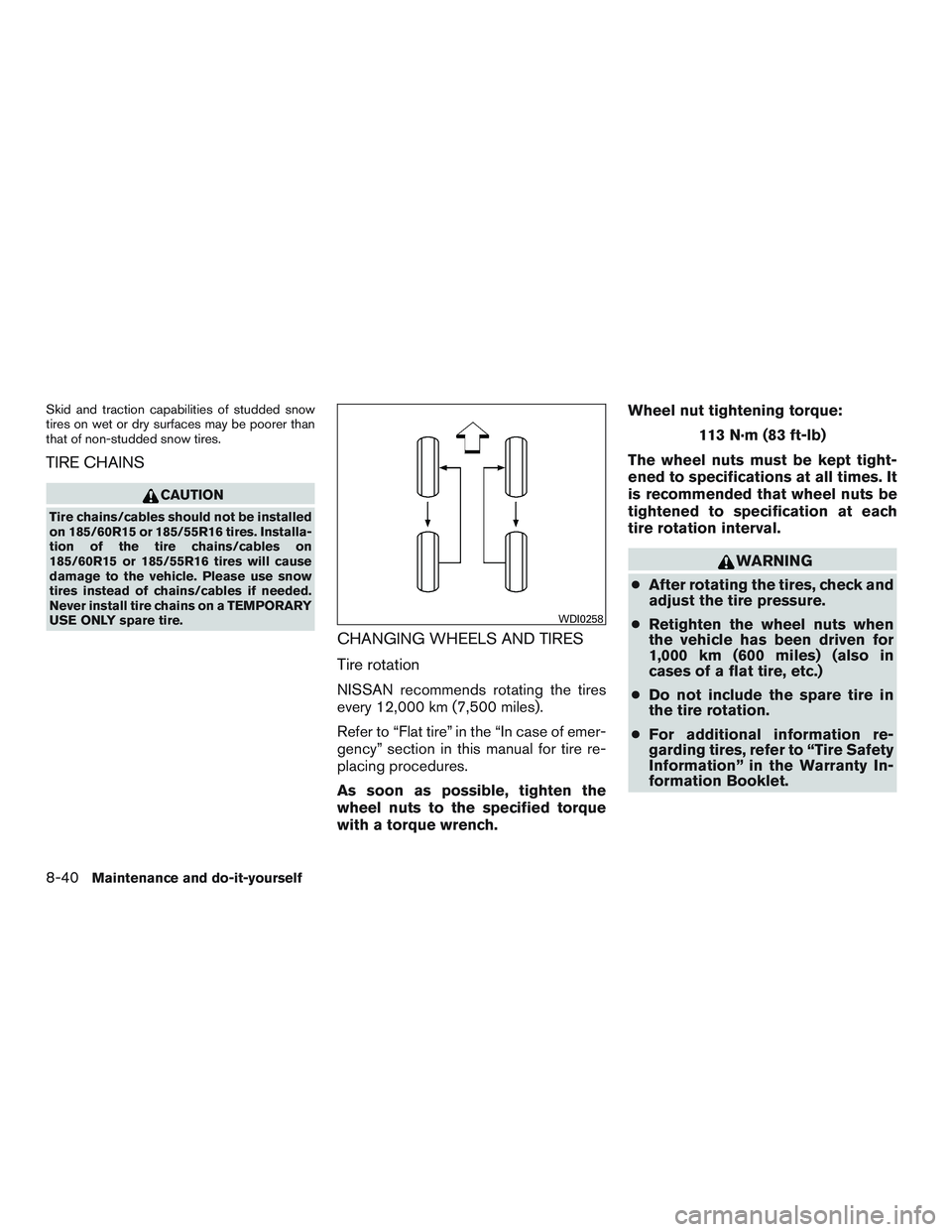
Skid and traction capabilities of studded snow
tires on wet or dry surfaces may be poorer than
that of non-studded snow tires.
TIRE CHAINS
CAUTION
Tire chains/cables should not be installed
on 185/60R15 or 185/55R16 tires. Installa-
tion of the tire chains/cables on
185/60R15 or 185/55R16 tires will cause
damage to the vehicle. Please use snow
tires instead of chains/cables if needed.
Never install tire chains on a TEMPORARY
USE ONLY spare tire.
CHANGING WHEELS AND TIRES
Tire rotation
NISSAN recommends rotating the tires
every 12,000 km (7,500 miles).
Refer to “Flat tire” in the “In case of emer-
gency” section in this manual for tire re-
placing procedures.
As soon as possible, tighten the
wheel nuts to the specified torque
with a torque wrench.Wheel nut tightening torque:
113 N·m (83 ft-lb)
The wheel nuts must be kept tight-
ened to specifications at all times. It
is recommended that wheel nuts be
tightened to specification at each
tire rotation interval.
WARNING
● After rotating the tires, check and
adjust the tire pressure.
● Retighten the wheel nuts when
the vehicle has been driven for
1,000 km (600 miles) (also in
cases of a flat tire, etc.)
● Do not include the spare tire in
the tire rotation.
● For additional information re-
garding tires, refer to “Tire Safety
Information” in the Warranty In-
formation Booklet.
WDI0258
8-40Maintenance and do-it-yourself
Page 262 of 293
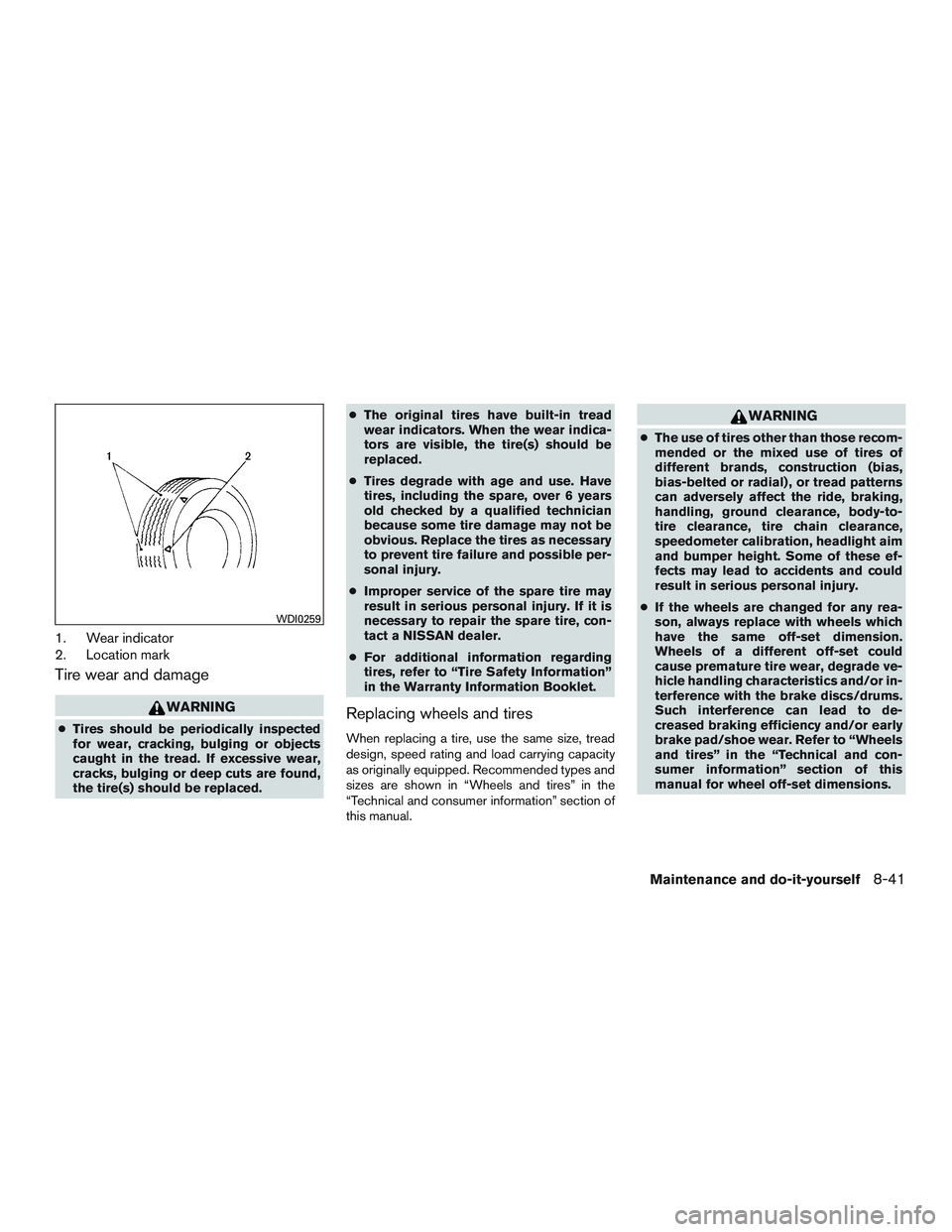
1. Wear indicator
2. Location mark
Tire wear and damage
WARNING
●Tires should be periodically inspected
for wear, cracking, bulging or objects
caught in the tread. If excessive wear,
cracks, bulging or deep cuts are found,
the tire(s) should be replaced. ●
The original tires have built-in tread
wear indicators. When the wear indica-
tors are visible, the tire(s) should be
replaced.
● Tires degrade with age and use. Have
tires, including the spare, over 6 years
old checked by a qualified technician
because some tire damage may not be
obvious. Replace the tires as necessary
to prevent tire failure and possible per-
sonal injury.
● Improper service of the spare tire may
result in serious personal injury. If it is
necessary to repair the spare tire, con-
tact a NISSAN dealer.
● For additional information regarding
tires, refer to “Tire Safety Information”
in the Warranty Information Booklet.Replacing wheels and tires
When replacing a tire, use the same size, tread
design, speed rating and load carrying capacity
as originally equipped. Recommended types and
sizes are shown in “Wheels and tires” in the
“Technical and consumer information” section of
this manual.
WARNING
● The use of tires other than those recom-
mended or the mixed use of tires of
different brands, construction (bias,
bias-belted or radial) , or tread patterns
can adversely affect the ride, braking,
handling, ground clearance, body-to-
tire clearance, tire chain clearance,
speedometer calibration, headlight aim
and bumper height. Some of these ef-
fects may lead to accidents and could
result in serious personal injury.
● If the wheels are changed for any rea-
son, always replace with wheels which
have the same off-set dimension.
Wheels of a different off-set could
cause premature tire wear, degrade ve-
hicle handling characteristics and/or in-
terference with the brake discs/drums.
Such interference can lead to de-
creased braking efficiency and/or early
brake pad/shoe wear. Refer to “Wheels
and tires” in the “Technical and con-
sumer information” section of this
manual for wheel off-set dimensions.
WDI0259
Maintenance and do-it-yourself8-41
Page 263 of 293
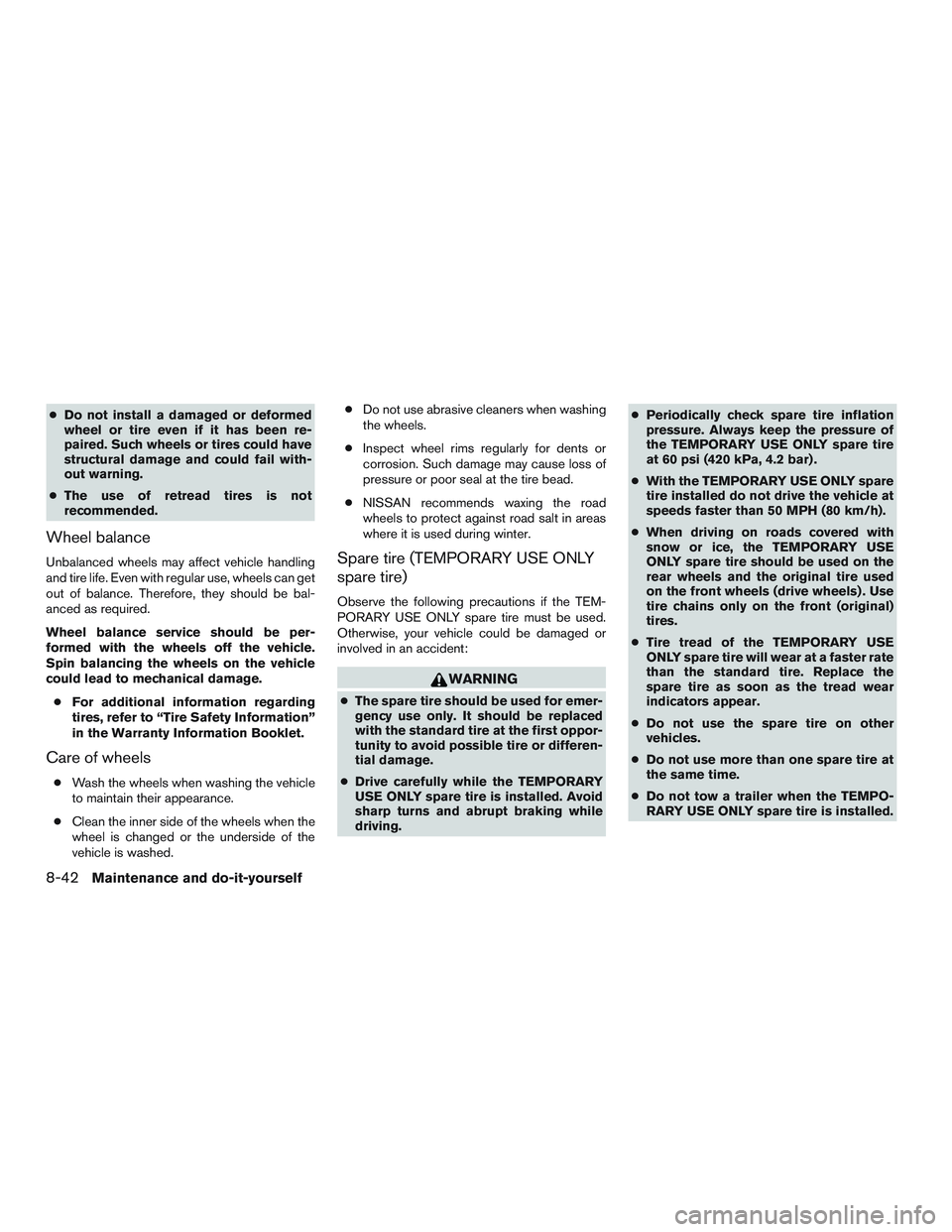
●Do not install a damaged or deformed
wheel or tire even if it has been re-
paired. Such wheels or tires could have
structural damage and could fail with-
out warning.
● The use of retread tires is not
recommended.
Wheel balance
Unbalanced wheels may affect vehicle handling
and tire life. Even with regular use, wheels can get
out of balance. Therefore, they should be bal-
anced as required.
Wheel balance service should be per-
formed with the wheels off the vehicle.
Spin balancing the wheels on the vehicle
could lead to mechanical damage.
● For additional information regarding
tires, refer to “Tire Safety Information”
in the Warranty Information Booklet.
Care of wheels
● Wash the wheels when washing the vehicle
to maintain their appearance.
● Clean the inner side of the wheels when the
wheel is changed or the underside of the
vehicle is washed. ●
Do not use abrasive cleaners when washing
the wheels.
● Inspect wheel rims regularly for dents or
corrosion. Such damage may cause loss of
pressure or poor seal at the tire bead.
● NISSAN recommends waxing the road
wheels to protect against road salt in areas
where it is used during winter.
Spare tire (TEMPORARY USE ONLY
spare tire)
Observe the following precautions if the TEM-
PORARY USE ONLY spare tire must be used.
Otherwise, your vehicle could be damaged or
involved in an accident:
WARNING
● The spare tire should be used for emer-
gency use only. It should be replaced
with the standard tire at the first oppor-
tunity to avoid possible tire or differen-
tial damage.
● Drive carefully while the TEMPORARY
USE ONLY spare tire is installed. Avoid
sharp turns and abrupt braking while
driving. ●
Periodically check spare tire inflation
pressure. Always keep the pressure of
the TEMPORARY USE ONLY spare tire
at 60 psi (420 kPa, 4.2 bar) .
● With the TEMPORARY USE ONLY spare
tire installed do not drive the vehicle at
speeds faster than 50 MPH (80 km/h).
● When driving on roads covered with
snow or ice, the TEMPORARY USE
ONLY spare tire should be used on the
rear wheels and the original tire used
on the front wheels (drive wheels) . Use
tire chains only on the front (original)
tires.
● Tire tread of the TEMPORARY USE
ONLY spare tire will wear at a faster rate
than the standard tire. Replace the
spare tire as soon as the tread wear
indicators appear.
● Do not use the spare tire on other
vehicles.
● Do not use more than one spare tire at
the same time.
● Do not tow a trailer when the TEMPO-
RARY USE ONLY spare tire is installed.
8-42Maintenance and do-it-yourself
Page 264 of 293
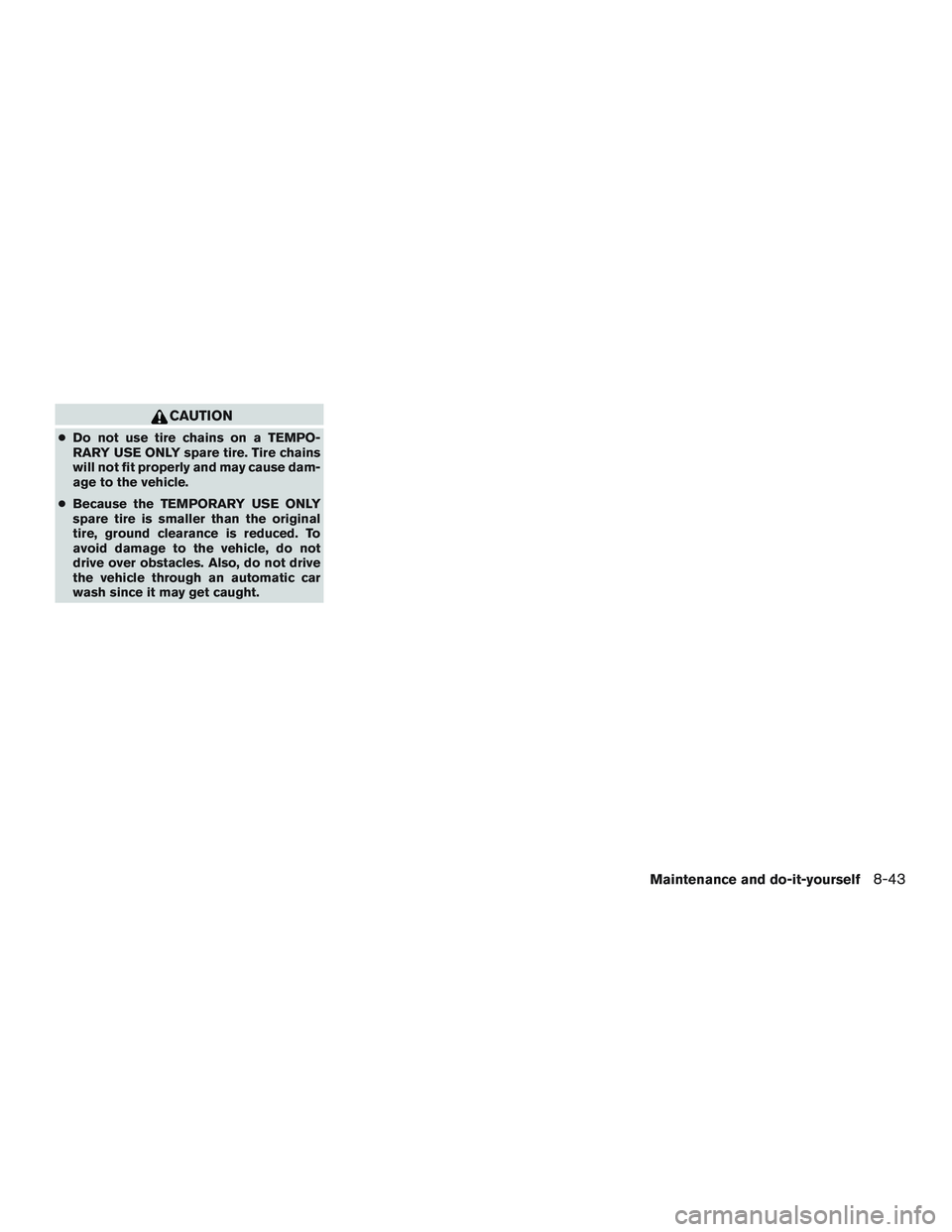
CAUTION
●Do not use tire chains on a TEMPO-
RARY USE ONLY spare tire. Tire chains
will not fit properly and may cause dam-
age to the vehicle.
● Because the TEMPORARY USE ONLY
spare tire is smaller than the original
tire, ground clearance is reduced. To
avoid damage to the vehicle, do not
drive over obstacles. Also, do not drive
the vehicle through an automatic car
wash since it may get caught.
Maintenance and do-it-yourself8-43
Page 265 of 293
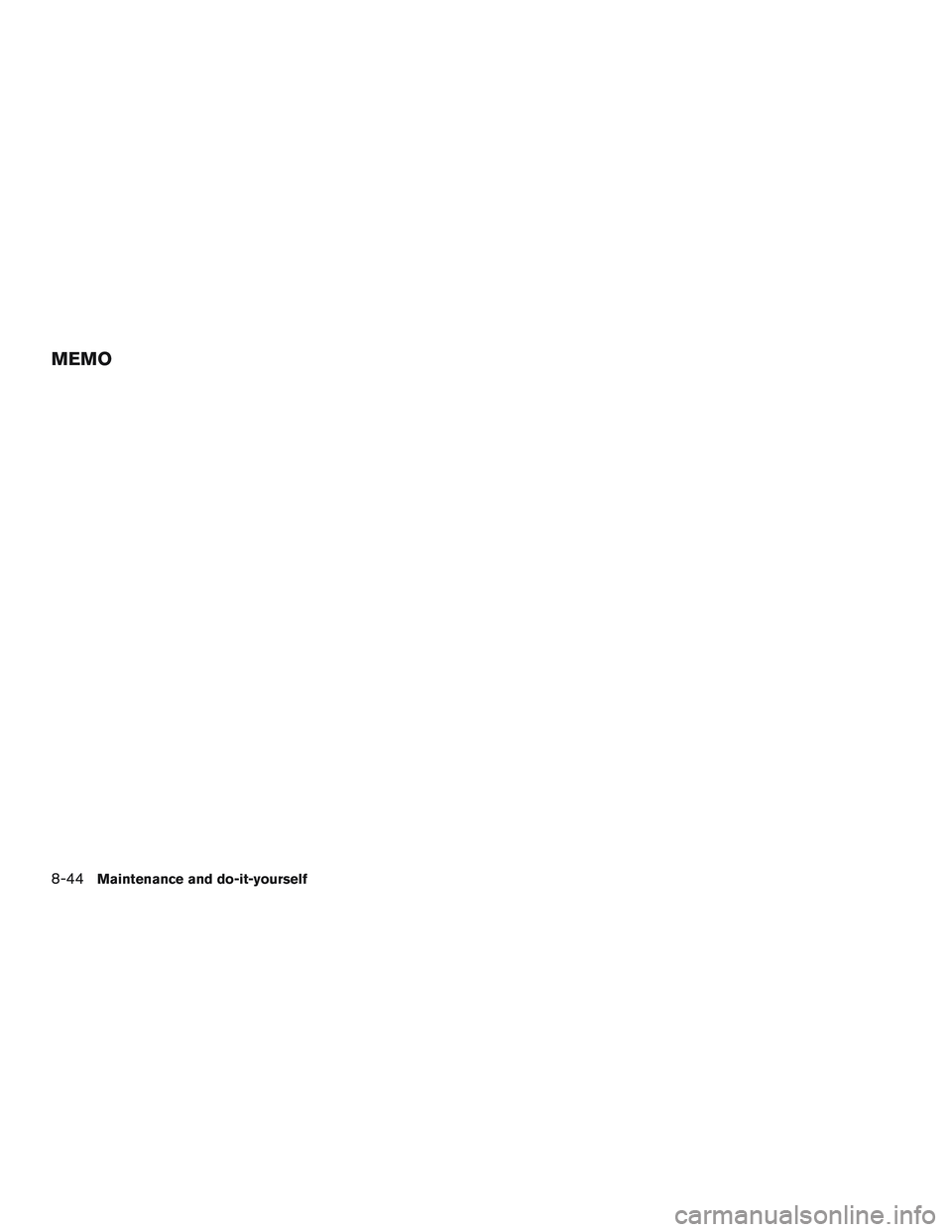
MEMO
8-44Maintenance and do-it-yourself
Page 266 of 293
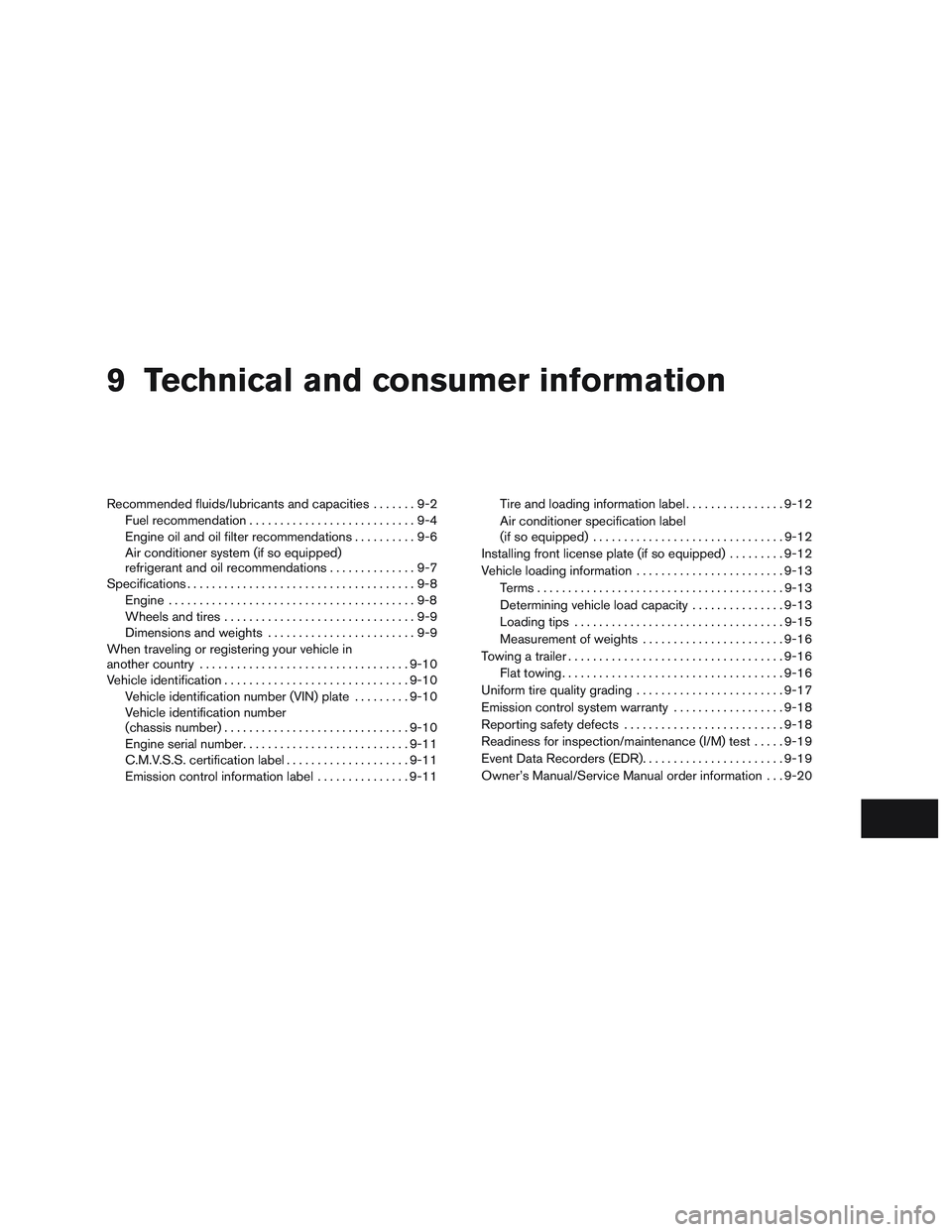
9 Technical and consumer information
Recommended fluids/lubricants and capacities.......9-2
Fuel recommendation ...........................9-4
Engine oil and oil filter recommendations ..........9-6
Air conditioner system (if so equipped)
refrigerant and oil recommendations ..............9-7
Specifications .....................................9-8
Engine ........................................9-8
Wheels and tires ...............................9-9
Dimensions and weights ........................9-9
When traveling or registering your vehicle in
another country .................................. 9-10
Vehicle identification .............................. 9-10
Vehicle identification number (VIN) plate .........9-10
Vehicle identification number
(chassis number) .............................. 9-10
Engine serial number ........................... 9-11
C.M.V.S.S. certification label ....................9-11
Emission control information label ...............9-11Tire and loading information label
................9-12
Air conditioner specification label
(if so equipped) ............................... 9-12
Installing front license plate (if so equipped) .........9-12
Vehicle loading information ........................9-13
Terms ........................................ 9-13
Determining vehicle load capacity . . .............9-13
Loading tips .................................. 9-15
Measurement of weights .......................9-16
Towing a trailer ................................... 9-16
Flat towing .................................... 9-16
Uniform tire quality grading ........................9-17
Emission control system warranty ..................9-18
Reporting safety defects .......................... 9-18
Readiness for inspection/maintenance (I/M) test .....9-19
Event Data Recorders (EDR) .......................9-19
Owner’s Manual/Service Manual order information . . . 9-20
Page 267 of 293
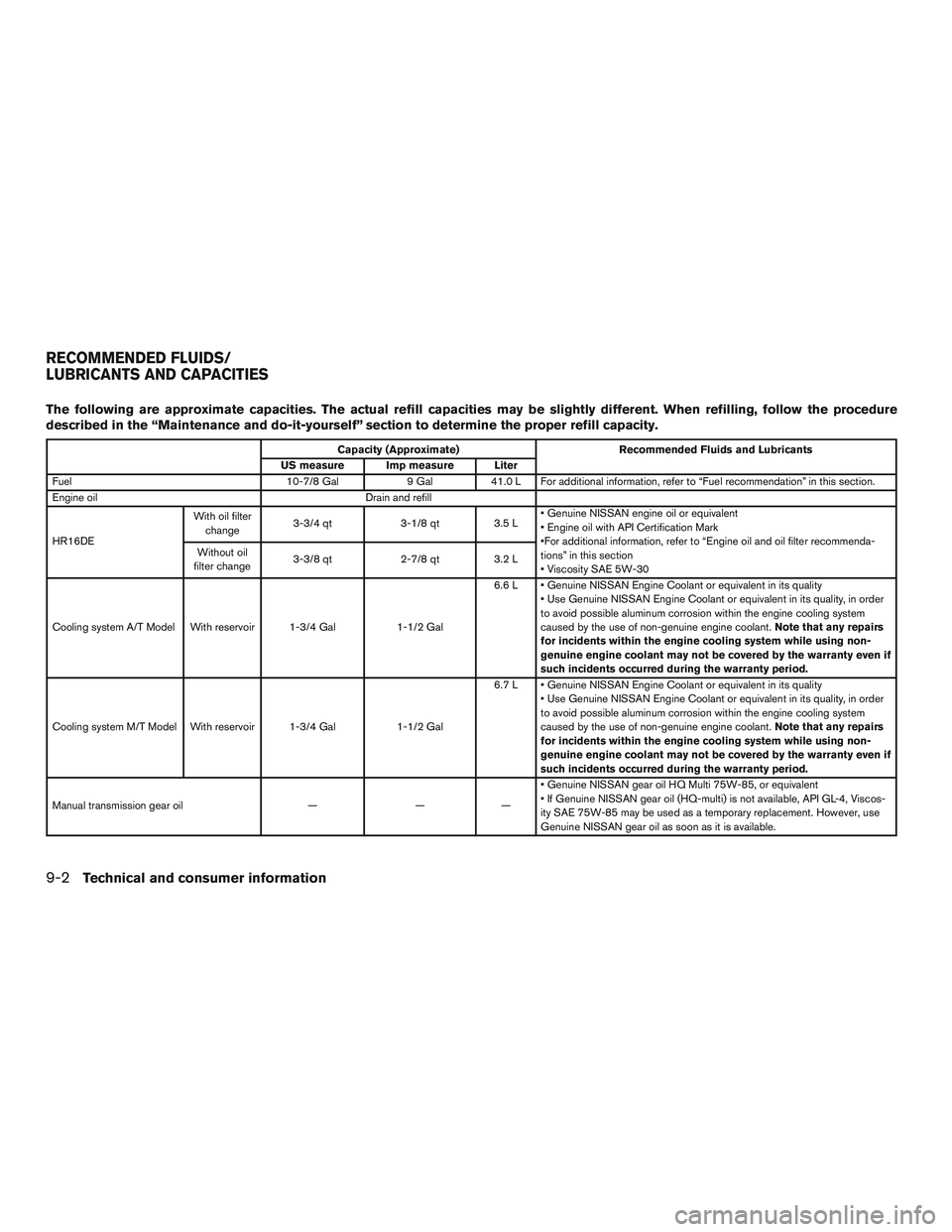
The following are approximate capacities. The actual refill capacities may be slightly different. When refilling, follow the procedure
described in the “Maintenance and do-it-yourself” section to determine the proper refill capacity.
Capacity (Approximate)Recommended Fluids and Lubricants
US measure Imp measure Liter
Fuel 10-7/8 Gal9 Gal41.0 L For additional information, refer to “Fuel recommendation” in this section.
Engine oil Drain and refill
HR16DE With oil filter
change 3-3/4 qt
3-1/8 qt3.5 L• Genuine NISSAN engine oil or equivalent
• Engine oil with API Certification Mark
•For additional information, refer to “Engine oil and oil filter recommenda-
tions” in this section
• Viscosity SAE 5W-30
Without oil
filter change 3-3/8 qt
2-7/8 qt3.2 L
Cooling system A/T Model With reservoir 1-3/4 Gal 1-1/2 Gal6.6 L • Genuine NISSAN Engine Coolant or equivalent in its quality
• Use Genuine NISSAN Engine Coolant or equivalent in its quality, in order
to avoid possible aluminum corrosion within the engine cooling system
caused by the use of non-genuine engine coolant. Note that any repairs
for incidents within the engine cooling system while using non-
genuine engine coolant may not be covered by the warranty even if
such incidents occurred during the warranty period.
Cooling system M/T Model With reservoir 1-3/4 Gal 1-1/2 Gal6.7 L • Genuine NISSAN Engine Coolant or equivalent in its quality
• Use Genuine NISSAN Engine Coolant or equivalent in its quality, in order
to avoid possible aluminum corrosion within the engine cooling system
caused by the use of non-genuine engine coolant. Note that any repairs
for incidents within the engine cooling system while using non-
genuine engine coolant may not be covered by the warranty even if
such incidents occurred during the warranty period.
Manual transmission gear oil ———• Genuine NISSAN gear oil HQ Multi 75W-85, or equivalent
• If Genuine NISSAN gear oil (HQ-multi) is not available, API GL-4, Viscos-
ity SAE 75W-85 may be used as a temporary replacement. However, use
Genuine NISSAN gear oil as soon as it is available.
RECOMMENDED FLUIDS/
LUBRICANTS AND CAPACITIES
9-2Technical and consumer information
Page 268 of 293
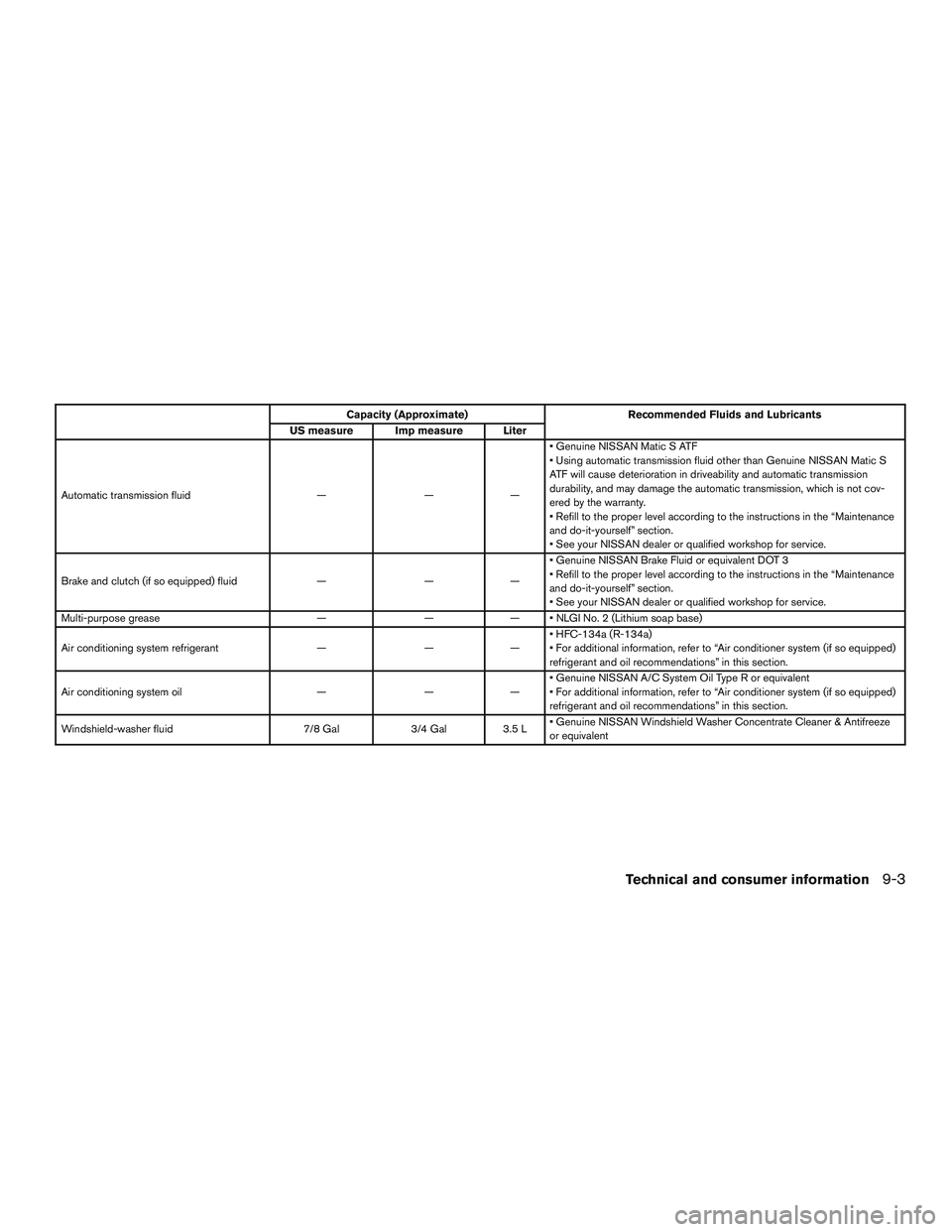
Capacity (Approximate)Recommended Fluids and Lubricants
US measure Imp measure Liter
Automatic transmission fluid ———• Genuine NISSAN Matic S ATF
• Using automatic transmission fluid other than Genuine NISSAN Matic S
ATF will cause deterioration in driveability and automatic transmission
durability, and may damage the automatic transmission, which is not cov-
ered by the warranty.
• Refill to the proper level according to the instructions in the “Maintenance
and do-it-yourself” section.
• See your NISSAN dealer or qualified workshop for service.
Brake and clutch (if so equipped) fluid ———• Genuine NISSAN Brake Fluid or equivalent DOT 3
• Refill to the proper level according to the instructions in the “Maintenance
and do-it-yourself” section.
• See your NISSAN dealer or qualified workshop for service.
Multi-purpose grease ——— • NLGI No. 2 (Lithium soap base)
Air conditioning system refrigerant ———• HFC-134a (R-134a)
• For additional information, refer to “Air conditioner system (if so equipped)
refrigerant and oil recommendations” in this section.
Air conditioning system oil ———• Genuine NISSAN A/C System Oil Type R or equivalent
• For additional information, refer to “Air conditioner system (if so equipped)
refrigerant and oil recommendations” in this section.
Windshield-washer fluid 7/8 Gal3/4 Gal3.5 L• Genuine NISSAN Windshield Washer Concentrate Cleaner & Antifreeze
or equivalent
Technical and consumer information9-3
Page 269 of 293
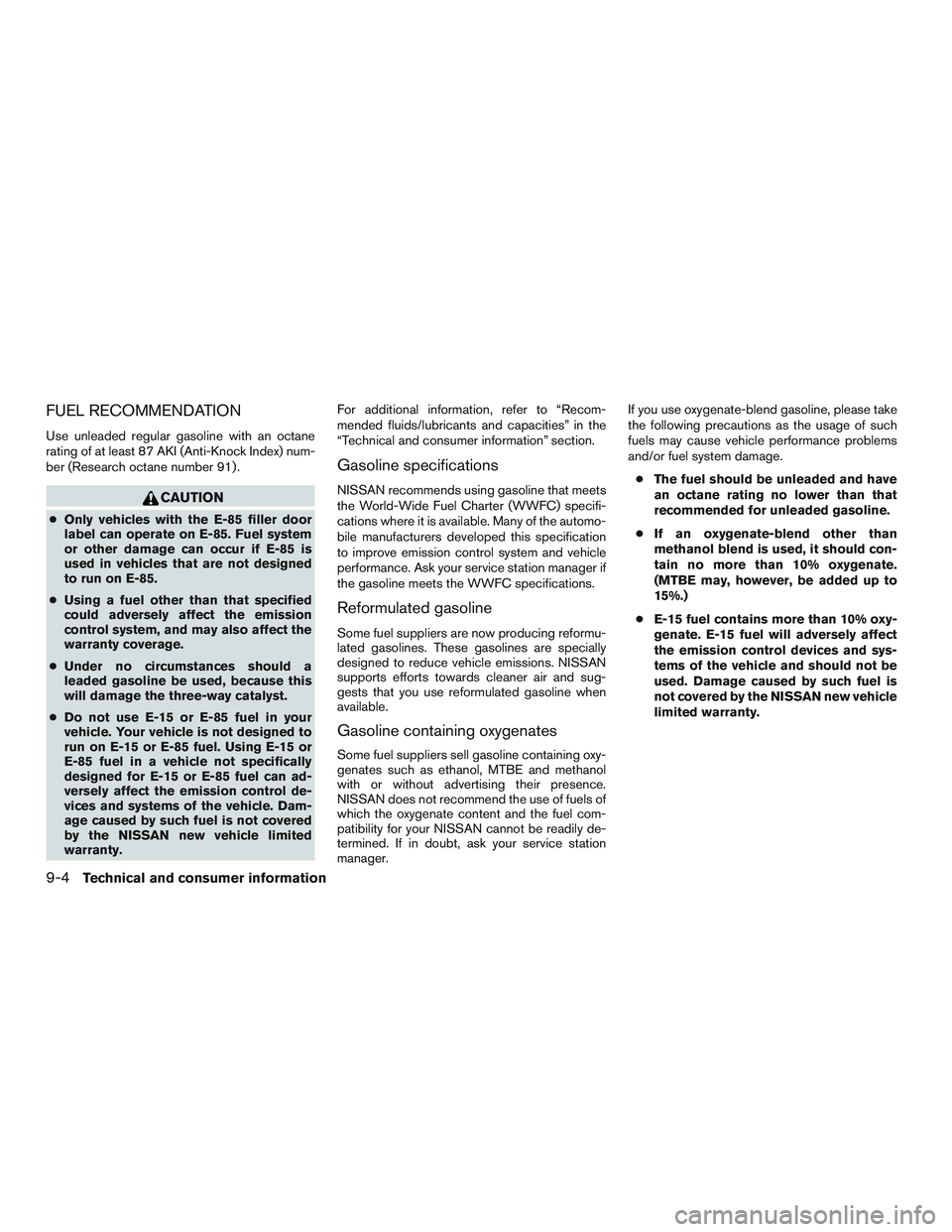
FUEL RECOMMENDATION
Use unleaded regular gasoline with an octane
rating of at least 87 AKI (Anti-Knock Index) num-
ber (Research octane number 91) .
CAUTION
●Only vehicles with the E-85 filler door
label can operate on E-85. Fuel system
or other damage can occur if E-85 is
used in vehicles that are not designed
to run on E-85.
● Using a fuel other than that specified
could adversely affect the emission
control system, and may also affect the
warranty coverage.
● Under no circumstances should a
leaded gasoline be used, because this
will damage the three-way catalyst.
● Do not use E-15 or E-85 fuel in your
vehicle. Your vehicle is not designed to
run on E-15 or E-85 fuel. Using E-15 or
E-85 fuel in a vehicle not specifically
designed for E-15 or E-85 fuel can ad-
versely affect the emission control de-
vices and systems of the vehicle. Dam-
age caused by such fuel is not covered
by the NISSAN new vehicle limited
warranty. For additional information, refer to “Recom-
mended fluids/lubricants and capacities” in the
“Technical and consumer information” section.
Gasoline specifications
NISSAN recommends using gasoline that meets
the World-Wide Fuel Charter (WWFC) specifi-
cations where it is available. Many of the automo-
bile manufacturers developed this specification
to improve emission control system and vehicle
performance. Ask your service station manager if
the gasoline meets the WWFC specifications.
Reformulated gasoline
Some fuel suppliers are now producing reformu-
lated gasolines. These gasolines are specially
designed to reduce vehicle emissions. NISSAN
supports efforts towards cleaner air and sug-
gests that you use reformulated gasoline when
available.
Gasoline containing oxygenates
Some fuel suppliers sell gasoline containing oxy-
genates such as ethanol, MTBE and methanol
with or without advertising their presence.
NISSAN does not recommend the use of fuels of
which the oxygenate content and the fuel com-
patibility for your NISSAN cannot be readily de-
termined. If in doubt, ask your service station
manager. If you use oxygenate-blend gasoline, please take
the following precautions as the usage of such
fuels may cause vehicle performance problems
and/or fuel system damage.
● The fuel should be unleaded and have
an octane rating no lower than that
recommended for unleaded gasoline.
● If an oxygenate-blend other than
methanol blend is used, it should con-
tain no more than 10% oxygenate.
(MTBE may, however, be added up to
15%.)
● E-15 fuel contains more than 10% oxy-
genate. E-15 fuel will adversely affect
the emission control devices and sys-
tems of the vehicle and should not be
used. Damage caused by such fuel is
not covered by the NISSAN new vehicle
limited warranty.
9-4Technical and consumer information
Page 270 of 293
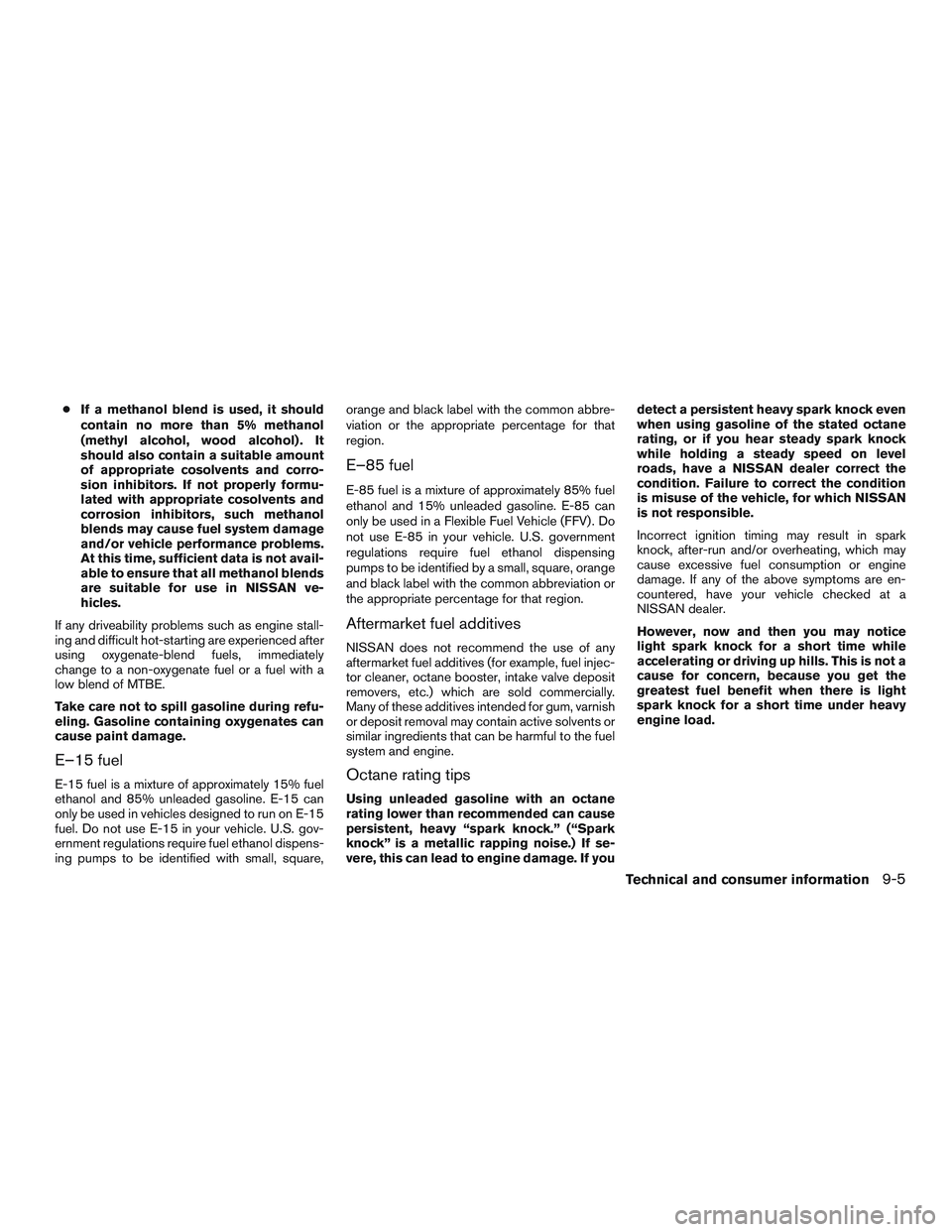
●If a methanol blend is used, it should
contain no more than 5% methanol
(methyl alcohol, wood alcohol) . It
should also contain a suitable amount
of appropriate cosolvents and corro-
sion inhibitors. If not properly formu-
lated with appropriate cosolvents and
corrosion inhibitors, such methanol
blends may cause fuel system damage
and/or vehicle performance problems.
At this time, sufficient data is not avail-
able to ensure that all methanol blends
are suitable for use in NISSAN ve-
hicles.
If any driveability problems such as engine stall-
ing and difficult hot-starting are experienced after
using oxygenate-blend fuels, immediately
change to a non-oxygenate fuel or a fuel with a
low blend of MTBE.
Take care not to spill gasoline during refu-
eling. Gasoline containing oxygenates can
cause paint damage.
E–15 fuel
E-15 fuel is a mixture of approximately 15% fuel
ethanol and 85% unleaded gasoline. E-15 can
only be used in vehicles designed to run on E-15
fuel. Do not use E-15 in your vehicle. U.S. gov-
ernment regulations require fuel ethanol dispens-
ing pumps to be identified with small, square, orange and black label with the common abbre-
viation or the appropriate percentage for that
region.
E–85 fuel
E-85 fuel is a mixture of approximately 85% fuel
ethanol and 15% unleaded gasoline. E-85 can
only be used in a Flexible Fuel Vehicle (FFV) . Do
not use E-85 in your vehicle. U.S. government
regulations require fuel ethanol dispensing
pumps to be identified by a small, square, orange
and black label with the common abbreviation or
the appropriate percentage for that region.
Aftermarket fuel additives
NISSAN does not recommend the use of any
aftermarket fuel additives (for example, fuel injec-
tor cleaner, octane booster, intake valve deposit
removers, etc.) which are sold commercially.
Many of these additives intended for gum, varnish
or deposit removal may contain active solvents or
similar ingredients that can be harmful to the fuel
system and engine.
Octane rating tips
Using unleaded gasoline with an octane
rating lower than recommended can cause
persistent, heavy “spark knock.” (“Spark
knock” is a metallic rapping noise.) If se-
vere, this can lead to engine damage. If youdetect a persistent heavy spark knock even
when using gasoline of the stated octane
rating, or if you hear steady spark knock
while holding a steady speed on level
roads, have a NISSAN dealer correct the
condition. Failure to correct the condition
is misuse of the vehicle, for which NISSAN
is not responsible.
Incorrect ignition timing may result in spark
knock, after-run and/or overheating, which may
cause excessive fuel consumption or engine
damage. If any of the above symptoms are en-
countered, have your vehicle checked at a
NISSAN dealer.
However, now and then you may notice
light spark knock for a short time while
accelerating or driving up hills. This is not a
cause for concern, because you get the
greatest fuel benefit when there is light
spark knock for a short time under heavy
engine load.
Technical and consumer information9-5